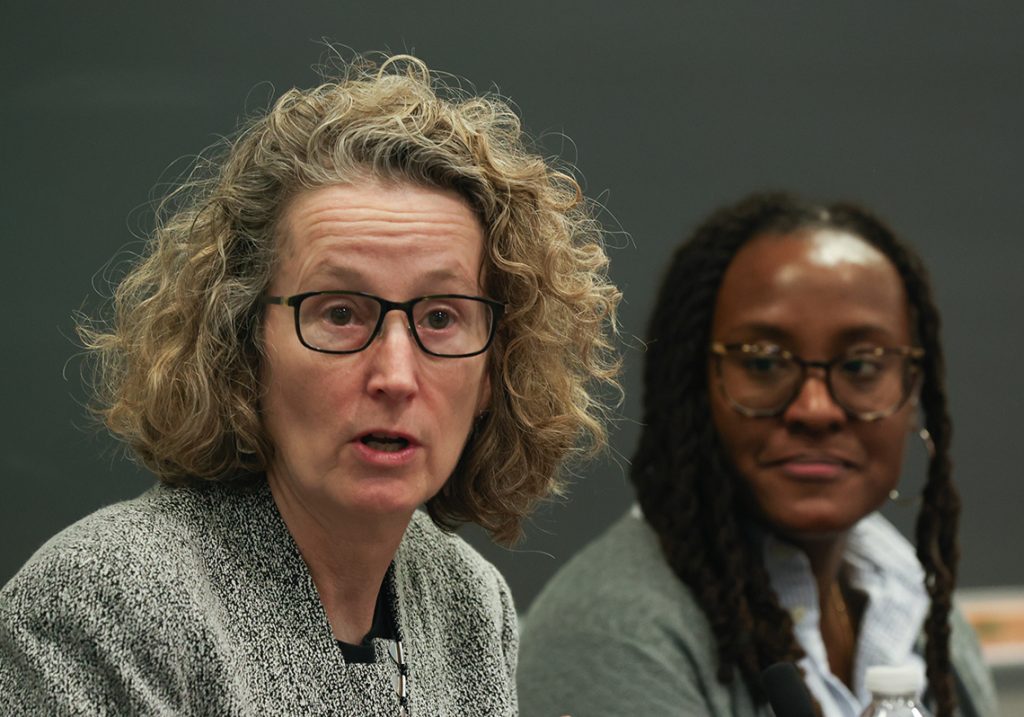Professor Dan Kanstroom opened with the poet Emma Lazarus’s much-celebrated sonnet from the base of the Statue of Liberty: “Give me your tired, your poor, your huddled masses yearning to breathe free…”
But, Kanstroom continued, “as any student of immigration history knows, this was always—at most—an aspiration. It was never a true description of the incredibly complex, often poignant, painful, and racist history of US immigration law and policy.”
On January 24, the Rappaport Center for Law and Public Policy kicked off its semester of programming with a panel discussion on one of the foremost political questions facing the nation today: How should the country—and, on a smaller scale, states and municipalities—manage the unprecedented surge in migrants and asylum-seekers crossing our borders? Kanstroom, moderator of the event and faculty director for the Rappaport Center, sought the input of a number of immigration experts to brainstorm solutions to a “unique crisis” created by “longstanding geopolitical forces, global pandemic, and climate change,” to name a few possible culprits.
The panel, entitled “Municipalities and Migrants: Balancing Compassion and Challenges,”began with Don Kerwin, senior research associate at the Keough School of Global Affairs at Notre Dame and former executive director of the Center for Migration Studies in NYC. Since the beginning of the COVID-19 pandemic, encounters between undocumented migrants and US Customs and Border Patrol have skyrocketed: 2 million in 2021, 2.8 million in 2022, and 3.2 million in 2023. If that pace keeps up, the nation is on track to hit 3.8 million in just the first few months of 2024, according to Kerwin. Mexico is, perhaps unsurprisingly, the principal source for these migrants.
He pointed to a number of crises simultaneously popping up across Central and South America as contributors to the nation’s immigration woes: “Between Venezuela’s economic collapse, Nicaragua’s descent into authoritarianism, Haiti’s teetering on the brink of state failure, and climate displacement in Guatemala … there are all sorts of systemic causes at play.” That’s not to mention the aftermath of COVID-19, which suddenly unleashed pent-up demand to migrate once travel restrictions were reduced.
Kerwin did not mince words when it came to the recent spate of politicians who have begun bussing migrants to sanctuary states—those that refuse to cooperate with federal immigration enforcement authorities—sometimes without telling the new arrivals where they were being sent.
“What they are trying to do is cause havoc in their sister communities across the United States, all for political gain, all with the intention of exposing the apparent hypocrisy of sanctuary jurisdictions, but these jurisdictions are anything but hypocritical. They’ve been happy to receive migrants all along, and strong immigrant communities have flourished in these states,” Kerwin said.
Presenters Susan Church (COO of the Commonwealth’s Office for Refugees and Immigrants) and Danielle Johnson (director of the City of Boston’s Office of Housing Stability) dove into what the migration crisis looks like on the ground of one of these sanctuary jurisdictions: Massachusetts.
“Massachusetts has a unique law,” Church said. “We have the only law in the country that guarantees the right to shelter for families across the entire state, and it is one of the many factors behind Massachusetts receiving—I would say its fair share—a large number of immigrants.” Coincidentally, Church pointed out, the Boston Herald published an editorial earlier that very day calling for the curtailing of the law.
These immigrants, Church said, tend to be extremely hard-working and eager to build productive lives in the United States. She recounted just one example of this industrious spirit: “I remember meeting a forklift operator who had just arrived from Haiti. He could speak Haitian Creole and Spanish and was nearly fluent in Portuguese, but had only just started to learn English. Knowing he wouldn’t have the luxury of time to become fluent in English, he took the test to become a forklift operator using Google Translate and passed his certification within two weeks.”
The chief hurdle facing Massachusetts in accommodating these migrants? An already-swamped state immigration apparatus struggling to juggle the staggering number of work authorization requests that come in on a daily basis.
The chief hurdle facing Massachusetts in accommodating these migrants? An already-swamped state immigration apparatus struggling to juggle the staggering number of work authorization requests that come in on a daily basis. To meet this demand, Church said, the state held a weeklong legal clinic that solicited help from over fifty attorneys from across the Commonwealth to process more than 1,200 work authorizations and 1,900 biometric documentations. This joint effort not only buoyed Church’s outlook on the crisis; it offered a glimmer of hope that Massachusetts could not just weather the crisis, but come out stronger for it.
Johnson highlighted the Catch-22 that the City of Boston currently faces in regard to the immigration crisis. “How can we support [our immigrant community] while also understanding that Boston and our lifelong constituents need assistance as well?” she asked, noting that she regularly fields xenophobic and racist phone calls from locals, many of whom are navigating similarly dire straits as recent migrants who arrive with little to nothing in their pockets. “But we can walk and chew gum,” Johnson reassured the crowd.
Most importantly, she stressed the importance of listening to the experiences of those making the journey to Massachusetts and other states in search of a better life. To that end, she closed with a quote from the Nigerian author Chimamanda Ngozi Adichie: “Stories matter. Stories have been used to dispossess and to malign, but stories can also be used to empower and to humanize. Stories can break the dignity of people, but stories can also repair that broken dignity.”
Photograph by Reba Saldanha


